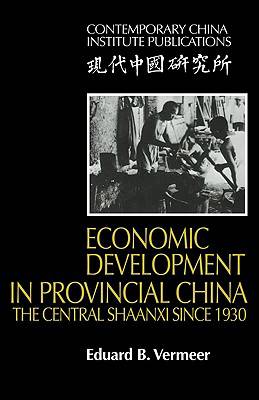
Door een staking bij bpost kan je online bestelling op dit moment iets langer onderweg zijn dan voorzien. Dringend iets nodig? Onze winkels ontvangen jou met open armen!
- Afhalen na 1 uur in een winkel met voorraad
- Gratis thuislevering in België vanaf € 30
- Ruim aanbod met 7 miljoen producten
Door een staking bij bpost kan je online bestelling op dit moment iets langer onderweg zijn dan voorzien. Dringend iets nodig? Onze winkels ontvangen jou met open armen!
- Afhalen na 1 uur in een winkel met voorraad
- Gratis thuislevering in België vanaf € 30
- Ruim aanbod met 7 miljoen producten
Zoeken
€ 72,45
+ 144 punten
Omschrijving
Dr Vermeer's study of the economic development on Central Shaanxi province from 1930 until 1988, when this was first published, illustrates the effects of famine, war and construction under Chinese communism. It focuses in particular on the organisational and technical potential of agriculture and industry to make use of the natural advantages of the region. Modernisation in Shaanxi was brought in from outside, with a dominant role for government institutions, and rapidly transformed the face of country and city. The book portrays the growing pains of a frontier economy, examining such crucial natural barriers to agricultural expansion as lack of irrigation water. It describes the technological advances, using clear maps to illustrate the development of transport, population distribution, soils, irrigation projects and cropping patterns. The extensive economy survey of counties in hill and plain areas, based on data from local government and the author's own observations, reveals great regional differences.
Specificaties
Betrokkenen
- Auteur(s):
- Uitgeverij:
Inhoud
- Aantal bladzijden:
- 552
- Taal:
- Engels
- Reeks:
Eigenschappen
- Productcode (EAN):
- 9780521115438
- Verschijningsdatum:
- 23/07/2009
- Uitvoering:
- Paperback
- Formaat:
- Trade paperback (VS)
- Afmetingen:
- 140 mm x 216 mm
- Gewicht:
- 693 g

Alleen bij Standaard Boekhandel
+ 144 punten op je klantenkaart van Standaard Boekhandel
Beoordelingen
We publiceren alleen reviews die voldoen aan de voorwaarden voor reviews. Bekijk onze voorwaarden voor reviews.











